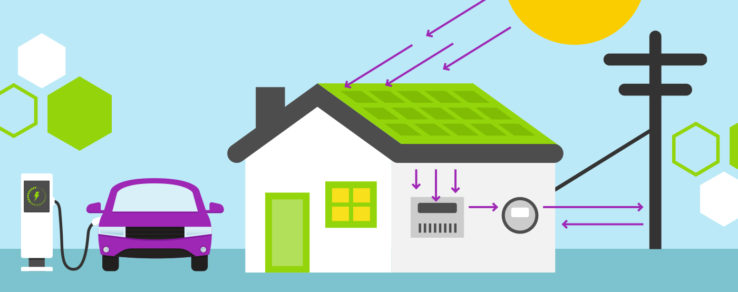As solar and other renewables become more affordable, many of the electric power consumers of yesterday are now active energy consumers and producers, or energy prosumers.
These utility customers invest in and install rooftop solar panels to generate the electricity they need and feed the excess electricity they produce back to the grid in exchange for credits or reductions to their energy bills.
Many households are also looking to battery electric vehicles and home battery storage systems that can be combined with solar panels to power their homes during outages. Some utilities, like PG&E in California, offer financial incentives to customers that install battery storage systems.
As electric consumption by U.S. households continues to climb, these energy prosumers will be a growing segment of a utility’s customer base. With approximately 4% of U.S. homes generating electricity from small-scale solar arrays, they already account for nearly one-third of all solar energy produced in the U.S. The International Energy Agency estimates that approximately 100 million households will rely on rooftop solar by 2030.
What is an Energy Prosumer?
An energy prosumer is a utility customer who generates their own power. For residential customers, this typically includes rooftop solar panels and home battery storage. Business customers may use larger-scale distributed energy resources (DERs), such as wind generation, solar arrays and battery storage.
Prosumers may sell their excess power back to the grid, becoming energy producers as well as consumers.
Building Relationships with Energy Prosumers
Energy prosumers are quickly changing the way utilities do business. Now that more and more customers are engaging with power production, these active customers will play a significant role as more renewable energy flows to the grid.
Utilities will be well served by educating and empowering these essential players, working with them as allies in meeting several mutually beneficial objectives:
- Meet renewable energy mandates. With many states now requiring utilities to generate a specific percentage of their power from renewable sources, utilities are encouraging their energy-supplying customers to help them meet their net zero goals. In those states, many utilities offer customers a solar renewable energy certificate (SREC) with rooftop solar systems for each megawatt-hour of electricity they generate. Homeowners can use these SRECs to generate income.
- Support solar investments. To encourage the adoption of solar, some utilities offer upfront rebates for installing solar panel systems that can, on average, reduce the cost of the system by as much as 20%.
- Build trust. Utilities are building portals that provide their most active customers with straightforward and comprehensive access to information about installing solar systems or designing microgrids, assistance connecting their systems to the grid, access to the real-time grid and market data, and more. This encourages them to rely on the utility as a trusted energy partner.
- Offer incentives. Forward-thinking utilities like Consumers Energy offer bill credits to energy prosumers for the extra energy they produce and discounts on the electricity they purchase. Utilities can also support their prosumer partners by providing discounts on maintenance and installation of solar equipment or technical support and educational services.
Building the utility-prosumer relationship benefits everyone. Customers are happier with lower bills and a reliable power supply during outages, while utilities can make progress toward their sustainability and customer satisfaction goals.
Marketing Tools to Encourage More Energy Prosumers
With the promise of a mutually beneficial relationship, why don’t all consumers become prosumers? It comes down to awareness, education, access and cost.
Awareness and Education
Many customers still don’t know they can return energy to the grid and get paid. Or that they can store power in batteries for future use. And if they do, many need help knowing where to get started.
For example, Super Bowl ads that showcased a Ford F-150 Lightning powering a home during an outage caught the attention of many customers previously uninterested in EVs. They were introduced to the idea of bidirectional charging but were left asking questions about its feasibility.
These newly interested customers need information on equipment, installation and safety. While the idea of sending energy back and forth might sound relatively simple, it’s a complex power conversion process that requires special chargers and careful installation.
Utilities can stand out in today’s crowded landscape with content — like email promotions, landing pages, checklists, blog posts and videos — that educate customers about the benefits of becoming a producer of renewable energy and guides them on how to get started.
Access and Cost
Even if an energy customer knows they want to become a prosumer, there are still hurdles to getting started. Finding reputable installers can be intimidating and the cost can feel out of reach.
For example, the Ford Charge Station Pro carries a price tag of $1,310, not to mention the F-150 Lightning vehicle, which ranges between $55,000 and $97,000.
Solar power storage systems aren’t cheap, either. Batteries can cost anywhere from $12,000 to $22,000.
Previously mentioned portals, incentives and rebates can make all the difference. Utilities that provide easy-to-access resources, like PSEG Long Island’s contractor list or PG&E’s incentive site, allow customers to act independently. Many customers want their utility to be a knowledgeable resource but still want to make home improvements on their own.
Opportunities to Grow with Energy Prosumers
The increasingly important role that energy prosumers play creates new opportunities for utilities to add value to their services and ramp up their efforts to ensure a resilient power grid. By using digital marketing tools and educational content to communicate with customers, the beneficial segment of prosumers can continue to grow.

